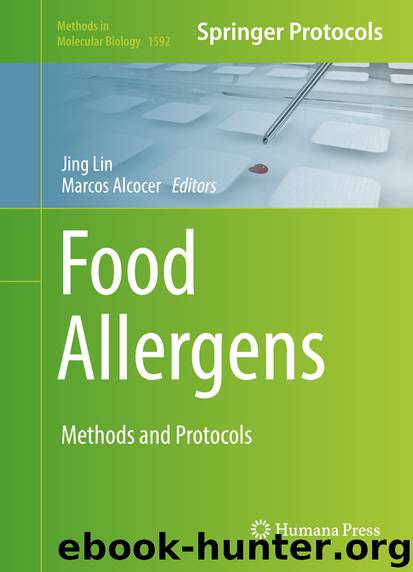Food Allergens by Jing Lin & Marcos Alcocer

Author:Jing Lin & Marcos Alcocer
Language: eng
Format: epub
Publisher: Springer New York, New York, NY
In contrast, the shape of a 384-well plate is an (inverted) truncated square pyramid with the square base surface area (Fig. 2b). Accordingly, the volume is determined as Volume of a truncated square pyramid V = 1⁄3 (a 2 + ab + b 2 )h, where a = R 2 = D 2/2, b = R 1 = D 1/2, and h = H 2. Accordingly, the volume is determined as V = 1/3(R 2 2 + R 1 R 2 + R 2 2)h, giving 26.27 mm3 or 0.026 cm3, while the base surface area (square) is S = R 2 2, where R 2 = D 2/√2 = 3.13 mm2 = 0.031 cm2.
So while the volume is reduced by a factor of 15.4 when transitioning from 96- to 384-well format, the surface is only decreased by 12.6-fold. Therefore, optimal conditions established for 96-well plates should take into account this difference when adapted to 384-well plates, for example, when deciding which concentration of optimal anti-IgE should be used as positive control in the assay. Without taking this into account, it is possible to reduce the efficiency of stimulation by entering the supraoptimal stimulation range. This is illustrated by a typical experiment shown in Fig. 3, in which RS-ATL8 cells sensitized overnight with the serum of a donor allergic to milk are stimulated with a wide range of allergen concentrations (1 pg/mL to 0.1 mg/mL). As can be seen, supraoptimal stimulations (leading to decreased measured reporter gene activation) are obtained with allergen concentrations higher than 100 ng/mL. The optimum stimulation conditions are therefore obtained in a relatively narrow range, although activation can also be measured outside this window. As could be expected and also shown in Fig. 3, the overall intensity of luciferase -induced chemiluminescence obtained is higher in 96-well plates, due to the higher cell numbers in each well. Also, the signal-to-noise ratio is slightly better in 96-well plates, but this may be offset by the advantage of using smaller volumes of serum and reagents when using 384-well plates.
Fig. 3RS-ATL8 cells were sensitized overnight with 1:50 diluted serum from a donor allergic to cow’s milk for 16 h in a 96-well (a) or 384-well (b) plate. After one wash, cells were stimulated with a wide range of concentrations of fractionated allergen and activation measured as luminescence 4 h after stimulation. Data are shown as mean ± s.d. for triplicate determination
Download
This site does not store any files on its server. We only index and link to content provided by other sites. Please contact the content providers to delete copyright contents if any and email us, we'll remove relevant links or contents immediately.
Men In Love by Nancy Friday(5162)
Everything Happens for a Reason by Kate Bowler(4680)
The Immortal Life of Henrietta Lacks by Rebecca Skloot(4527)
Why We Sleep by Matthew Walker(4361)
The Sports Rules Book by Human Kinetics(4297)
Not a Diet Book by James Smith(3341)
The Emperor of All Maladies: A Biography of Cancer by Siddhartha Mukherjee(3069)
Sapiens and Homo Deus by Yuval Noah Harari(2988)
Day by Elie Wiesel(2721)
Angels in America by Tony Kushner(2596)
A Burst of Light by Audre Lorde(2548)
Endless Forms Most Beautiful by Sean B. Carroll(2431)
Hashimoto's Protocol by Izabella Wentz PharmD(2331)
Dirty Genes by Ben Lynch(2272)
Reservoir 13 by Jon McGregor(2242)
Wonder by R J Palacio(2141)
And the Band Played On by Randy Shilts(2131)
The Immune System Recovery Plan by Susan Blum(2030)
Stretching to Stay Young by Jessica Matthews(2001)
